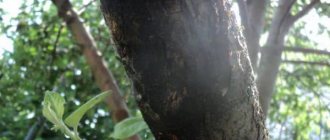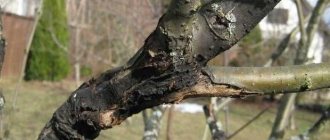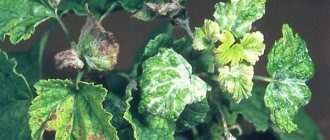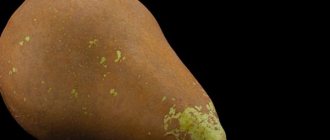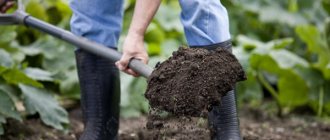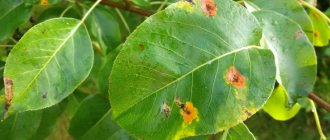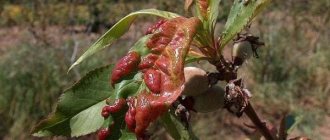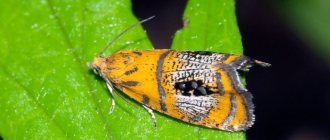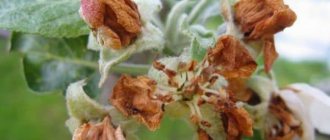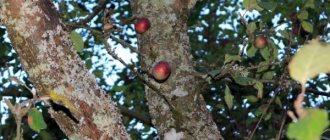Author: Natalya Category: Plant Diseases Published: September 19, 2016Republished: February 20, 2019Last edits: July 16, 2020
- Apple scab
- Scab on gooseberries
Scab is a dangerous infectious plant disease caused by microscopic pathogenic fungi, actinomycetes and bacteria. It affects and deforms the surface of leaves, shoots, tubers and fruits, which greatly reduces the yield. Scab disease is widespread in temperate climates. There is scab of fruit trees and shrubs, as well as types of scab that attack potato and beet tubers.
Scab disease - description
Each plant species has its own scab pathogen, and potato scab is unlikely to spread to an apple tree, and scab on an apple tree is caused by different pathogens than scab on a pear. But the symptoms of various types of scab are similar. External signs of the disease are peeling of the skin, the appearance of spots, pustules, ulcers and warts on the surface of fruits, leaves, tubers, stems, shoots and flowers.
With severe damage, the leaves dry out and fall off, the water balance of the plant is disrupted, which negatively affects fruiting not only this year, but also the next year. Affected buds and flowers also fall off, and fruit scab makes them ugly. In addition, during storage, fruits are subject to rot, the pathogens of which penetrate through cracks in the peel that arise as a result of the development of scab.
Scab damage occurs under certain conditions. For example:
- Potatoes: treatment before planting
- when the soil moisture is too high. The presence of moisture is a prerequisite for the development of the disease. The activity of the fungus manifests itself in the spring at an air temperature of 12 ºC in conditions of melting snow. In summer, the development of scab is facilitated by frequent dew, fog and rain;
- if the planting is too dense. In gardens where trees of the same species are located close to each other, scab on plants spreads quite quickly, especially when the rows are covered with herbs, which serve as a bridge for the transfer of spores from one tree to another;
- with genetic uniformity, that is, when trees of the same species grow next to each other. If a pear or plum grows near an apple tree, then the scab that has infected the apple tree may not harm the neighboring trees, but if several apple trees grow on the site in close proximity to each other, it is only a matter of time before neighboring trees are infected with scab;
- with susceptibility of the variety. It has been observed that some varieties and hybrids are more susceptible to scab than others. Thanks to breeders, scab-resistant varieties have now been developed.
Causes of infection (sources, provoking factors)
The disease develops due to damage to trees by the marsupial fungus – Venturia inaequalis. Its spores are carried by the wind and travel long distances with the help of birds, domestic and wild animals. Favorable conditions for the occurrence and development of infection are:
- wet weather (especially after rain);
- frequent fogs;
- excess moisture in the soil.
The fungus actively spreads (the first signs of infection appear within a week), it can withstand cold and is resistant to temperature changes, so it is very difficult to fight it.
Scab control
Scab treatment
How to get rid of scab? The most effective, fastest, and sometimes the only way to combat the disease is to treat plants with chemicals. Trees are treated for scab with fungicides - Bordeaux mixture, Zato, Hom, Skor, Fitosporin and many other drugs.
Scab treatment takes place in several stages, and it is very important to choose the right timing of treatment. And for this you need to know when the spread of fungal ascospores begins and ends. The first scab treatment is carried out in the green cone phase, the second – in the pink cone phase and the third, most important treatment – after the petals fall. In summer, scab spraying is carried out at intervals of 2-3 weeks. In years with high humidity, it will be necessary to carry out five or six scab treatments on trees.
Scab disease - prevention
Protection against scab - timely preventive measures - is of great importance for the fight against the disease. How to fight scab using agricultural techniques? It is necessary to promptly remove fallen leaves from under bushes and trees and dig up the soil in the tree trunks. During the growing season, inspect trees as often as possible so as not to miss the onset of disease damage. Remove suspicious leaves and fruits immediately. Do not skip the annual thinning pruning of bushes and trees, as scab develops much faster in thickened crowns.
Fertilize plants foliar with fertilizers based on potassium carbonate, phosphorus and silicon, for example, Opty Sil and Solfan PK, and in the fall, after leaf fall, treat trees, bushes and the soil under them with a seven percent urea solution, a ten percent solution of Nitroammophoska or a ten percent solution of ammonium nitrate. Treatment is carried out at an air temperature of at least 4 ºC. This measure will allow your plants to receive additional nutrition, and at the same time destroy most of the pests and pathogenic microflora.
Chemicals
The following fungicides can be used against scab:
In stores, depending on the city, you can find others.
Application of fungicides
When choosing a fungicide, pay attention to the active ingredients. Preference should be given to popular brands, however, it is advisable to regularly change medications so that the fungus does not adapt. Alternatively, do this seasonally.
It is better to carry out the treatment in the morning or evening. For maximum effectiveness, this should be done after rain, when the trunk is more prepared for the procedures. Heavily infested trees must be treated regularly for several years.
The symbiosis of using chemicals and folk remedies will give the best results. With an integrated approach, it is possible to get rid of the fungus in one season.
Related article: Ramulariasis of plants, how to treat
Scab on trees
Apple scab
Most often, scab affects apple trees. First, leaf scab appears - olive-colored spots appear on their upper side, covered with a velvety coating of fungal spores. The leaves are starting to fall. Then comes the turn of the fruits: brown spots appear with a lighter rim and a velvety coating, which gradually disappears, and cork tissue is revealed underneath. These corky spots enlarge, crack, and often merge with each other. The fruits take on ugly shapes and are poorly stored.
More often than other varieties, Grushovka Moskovskaya, Slavyanka, Borovinka, Antonovka, Papirovka, Bellefleur-Chinese are infected with scab. The varieties resistant to the disease are Pepin saffron, Jonathan, Kitayka anisovaya, Rodnichok, Soyuz, Fortuna, Juno, Rassvet, Fairy, Red Amber, Golden Summer, Lyubava, Vasilisa, Orpheus, Margot, Nocturne, Talida, Ekaterinodarskoe and others.
How to treat scab on an apple tree? Combining agrotechnical measures and chemical treatment of plants. Affected shoots must be cut off, fallen leaves and fruits must be collected and burned, weeds must be pulled out - tree trunks must be kept clean. In the fall, the soil under the trees is dug up. In early spring, sanitary and thinning pruning of crowns is carried out.
What are the diseases of apple trees and their treatment?
Preventive treatment of apple trees against scab is carried out before the start of sap flow with the drug DNOC (100 g per 10 l of water) or a solution of Nitrafen emulsion (200 g per 10 l of water). Therapeutic treatments of apple trees for scab begin in the green cone phase with one percent Bordeaux mixture, and in the pink bud phase the tree is treated with Skor, dissolving 2 ml of the product in 10 liters of water.
If you missed the moment and did not treat the apple tree with DNOC or Nitrafen on the dormant buds, then in the green cone phase you can carry out a “blue” spraying - not with one percent, but with three to four percent Bordeaux mixture, and the treatment in the pink bud phase can be skipped.
The following treatments of apple trees against scab are carried out at intervals of 2-3 weeks, alternating the preparations Zineb or Captan in the form of an emulsion (50 g per 10 liters of water), colloidal sulfur in the form of a suspension (100 g per 10 liters of water) and Khom (40 g per 10 l water). Stop processing no later than a month before harvest. In years when scab affects trees en masse, it is necessary to carry out another treatment of the trees after harvesting with a one-percent solution of Bordeaux mixture or a half-percent solution of the drug Zineb.
How to grow healthy apple trees in the garden - planting and care
Scab on a pear
The symptoms of scab on a pear are the same as on an apple tree, only spots on the leaves appear not on the top side, but on the bottom, and in addition to leaves and fruits, as on an apple tree, scab on a pear also affects young shoots. The scab pathogen overwinters on pear branches and on fallen leaves under the tree.
The first signs of scab on a pear can be detected 2-3 weeks after bud break. If the fungus infection occurs early, in spring or early summer, the spots on the fruits and leaves will be large, but with a later infection the spots will be small. Late scab appears in those years when there is wet weather before harvesting - the spots in this case may be almost invisible, but they will appear during storage. This fruit is called a “warehouse pear.”
On shoots affected by scab, the bark becomes covered with small blisters, becomes rough and peels off. The pear varieties most often affected by scab are Forest Beauty, Bergamot Mlievsky, Sapezhanka, Bere Ligelya winter. Bere Gardi, Bere Ardanpon, Bere Bosch, Mlievskaya osennyaya, Lyubimitsa Klappa, Vrodlyva, Vyzhnitsa, Etude, Trembita, Zolotovorotskaya, Stryiskiya and others are relatively resistant to the disease.
- Moniliosis: treatment and prevention, control measures
How to deal with scab on a pear? First of all, collect and burn fallen fruits and leaves. In the spring, trim the crown of the tree, not allowing it to thicken and burning all dry and scabbed shoots after pruning. In autumn, rake and burn fallen fruits and leaves. To destroy scab pathogens hibernating in the bark and soil under trees in late autumn and early spring, dig up the soil in the tree trunk circle and treat the tree and the soil underneath with a one-percent solution of the drug DNOC or a three-percent solution of Nitrafen. For one hundred square meters you will need 20 liters of solution.
How to grow pears healthy - care and planting
Spring treatment for scab of pear trees affected by scab begins at the same time as the treatment of apple trees: during the green cone phase, “blue” spraying is carried out with three percent Bordeaux mixture. During the pink bud phase, treatment is carried out with the drug Skor (2 g per 10 liters of water), after flowering the treatment with Skor is repeated. 10-14 days after the pear leaves have hardened, and then again three weeks later, the plant is treated against scab with one of the drugs such as Skor, Hom, Zineb, Captan, colloidal sulfur or another chemical of similar action.
Scab on apricot and peach
Scab of stone fruit trees is not as common as scab of pome trees, but nevertheless it can cause significant damage. The likelihood of scab disease in stone fruit crops increases in conditions of high humidity and moderate air temperatures. As soon as the temperature rises to 30 ºC, the development of the disease slows down significantly.
The first signs of scab on apricot and peach fruits appear in the form of brownish-green spots with a vague outline. As the disease progresses, the spots darken, enlarge, an olive or black velvety coating forms on them, and their boundaries become clearer. With severe scab damage, the spots merge to form a crust. Fruit growth slows down, cracks and sores appear on them, into which pathogens of fruit rot penetrate. Sick fruits often fall off.
Planting and caring for peach in the garden
Scab-affected shoots lag behind in development, the leaves on their undersides are covered with brown or pale green blurry spots.
The most sensitive to scab are the apricot varieties Red-cheeked, Shalah and the entire “pineapple” group.
For preventive treatment of apricots on dormant buds, use three to four percent Bordeaux mixture or any other copper-containing preparation. In the first ten days of June, apricots are treated directly against scab with Horus, Skor or Captan in accordance with the instructions. After two weeks, the treatment is repeated. Further spraying of apricot will not bring any results, unless after leaf fall you treat the tree with one percent Bordeaux mixture. The best scab treatments for apricots are copper-containing fungicides.
Rules for growing apricots in the garden
And do not forget to carry out all agrotechnical measures to care for the tree.
Scab on plum
Scab affects plums under the same conditions and manifests itself with the same symptoms as in the case of other stone fruit crops. Therefore, the treatment is carried out according to the same principle as the treatment of apricot: dormant buds are sprayed with “blue” spraying, and in the first ten days of June the plant is treated with Skor or Horus. After two weeks, the treatment is repeated. The next spraying is carried out after leaf fall with one percent Bordeaux mixture.
Planting plums and caring for them in the garden - growing rules
Scab on cherry
Cherries, like other stone fruit tree species, are not so often affected by scab, however, if this happens, it is not the scab that causes severe damage to the plant, but the causative agents of various rots that penetrate into the cracks in the fruit formed as a result of the development of the disease. That is why measures to combat scab on cherries should be carried out in early spring in the same order and using the same methods as we described in the section on scab on apricots.
Growing cherries - how to plant and care
Scab on fruit trees
Scab often infects not only pome and stone fruit crops, but also citrus fruits, but in our latitudes neither lemons, oranges, nor tangerines grow in gardens, and we will tell you how to save homemade citrus fruits from scab in another article. As for crops such as peach, cherry plum, cherry and quince, you can get rid of scab in the same time frame and using the same methods as apple trees, pears and apricots. By the way, preventive measures to improve the health of your garden are the same for all fruit trees.
Methods for preventing the disease
It is always better to prevent any disease, so professional gardeners recommend taking preventive measures to prevent the appearance of scab:
- Plant trees in a well-lit area.
- Whiten the trunk and skeletal branches in spring and autumn.
- Clean off the old bark, which begins to flake off and serves as a source of many infections.
- Pruning the crown so that there is no thickening and the branches do not shade each other.
- Remove fallen leaves in the fall and burn them, since the pathogen overwinters on them.
- Digging the soil under the trees.
- Remove not only diseased leaves from trees, but also shoots and branches.
- Carry out preventive treatments with Bordeaux mixture, copper sulfate or the chemical preparation "Agat-25 K" in early spring during bud break.
- Remove weeds under trees and mulch the soil. Humus, peat and compost work well as mulch.
- Plant trees at the recommended distance from each other.
- Do not plant potatoes and bulbous flowers between the rows of the garden, as they can also be affected by this disease.
- Carry out timely watering and fertilizing.
- Carry out regular inspection of trees to detect the disease in time.
Related article: Asparagus plant: growing from seeds, photos, planting and care, types and varieties
Treatment for bush scab
Scab on gooseberries
Scab on gooseberries is often referred to as powdery mildew, although these are two different diseases, so before taking action, compare the symptoms of these two diseases and make sure that there really is scab on the gooseberry.
How to treat gooseberries against scab? In order to minimize the risk of gooseberry scab, as a preventive measure in early spring, on still dormant buds, treat it with a seven percent urea solution, trying to thoroughly moisten the leaves, branches and soil under the bushes with the preparation. In the fall, after leaf fall, remove fallen leaves from under the bushes, dig up the tree trunk and carry out the same treatment with urea.
As a treatment for gooseberry bushes affected by scab, swollen buds are treated with two or three percent Bordeaux mixture or a mixture of Aktara with Horus. A month later, the treatment with Horus and Aktara is repeated.
- Cucumbers: why they turn yellow in the greenhouse and in the garden
Treating gooseberries against diseases and pests
Currant scab
Currants are not affected by scab to the same extent as gooseberries, but in order not to risk the harvest, measures to combat the disease must be taken in early spring. Since currants and gooseberries are related crops, scab on currants is destroyed in the same ways as scab on gooseberries, you just need to make sure that you are dealing with scab and not powdery mildew.
Currant diseases and their treatment and prevention
Advice from experienced gardeners
Not every summer resident knows how to get a good harvest of apples. In order to avoid making simple mistakes and enjoy delicious fruits, you should take note of the recommendations of the experts:
- The garden must always be clean, so you will have to remove weeds, fallen apples and leaves.
- It is extremely important not to plant perennial crops near apple trees that are suitable for overwintering the scab fungus. It is better to make beds at some distance from the trees.
- The tree trunk circles must be clean. Mulch and ash will prevent the development of infections.
- When choosing planting material, you need to pay attention to the variety of apple trees. Breeders indicate the variety's resistance to diseases; the information will be useful.
- Before planting new apple trees from the nursery, you need to make sure they are healthy. Otherwise, there is a high risk of infecting the garden with scab or other parasites.
When treating wood during the growing season, the entire garden must be sprayed. Breaks in prevention cannot be taken - simultaneous treatment does not give the infection a chance of survival.
Potato scab
Potato scab most often affects the surface of tubers, causing the appearance, seed and taste qualities of potatoes to deteriorate and their ability to be stored for a long time is lost. If the damage is severe, the potatoes become unsuitable for eating. Potatoes cannot be grown in areas infected with scab for at least 4-5 years.
Potatoes are affected by the following types of scab: common, tuberous (oosporosis), black (rhizoctoniosis), silver and powdery. Common scab appears as small, shallow, irregular ulcers on the surface of tubers. As the disease progresses, the spots grow, and sometimes merge and become covered with corky formations. When digging up potatoes, you can see a cobwebby coating on the tubers, which disappears as soon as they dry.
Powdery scab occurs when tubers, roots and stolons are infected by the pathogen through eyes and wound areas. Galls form on the roots in the form of white growths of irregular shape, darkening over time, and the surface of the tubers is covered with warty pustules, which, when the potatoes ripen, turn into ulcers with a dusty brown mass. During storage, diseased tubers are often affected by late blight and dry rot.
Silver scab can be recognized on tubers during harvesting or already in storage. It looks like inconspicuous matte light brown spots of various shapes and sizes. The development of the disease occurs closer to spring: the affected tissue becomes as if depressed and acquires a metallic sheen. In case of severe damage, the peel shrinks due to the loss of moisture from the tuber.
Lumpy scab, or oospora, affects potatoes in the field during the period of tuber growth, but symptoms of the disease can only be detected during storage. Round pustules are formed on the surface of the tubers, not different in color from the peel. They can be depressed, convex or flat. The pustules grow and form areas that resemble late blight, but without rot under the skin.
Black scab, or rhizoctonia blight, is the most dangerous of all types of potato scab, causing a 20% reduction in yield. It destroys tubers, curls the apical leaves, covers the root parts of the plant with mold and causes rot and subsequent death of the shoots.
To avoid potato scab infection, you should use only high-quality and healthy planting material, which must be treated with Fito Plus, Rovral or Aquaflo before planting. If you add boron, manganese and copper to the soil, this will significantly reduce the risk of potato scab. An important preventative measure is to observe crop rotation: alternate growing potatoes on the plot with growing legumes, and if you do not have the opportunity to change the plot for potatoes, then at least do not use fresh manure as fertilizer.
The soil with a shift towards the alkaline side must be acidified with a solution of 2 tablespoons of ammonium sulfate in 10 liters of water - this mixture is used to water the area with potatoes during flowering, using a liter of solution for each bush. Two weeks before harvesting potatoes, mow the tops - this will allow the tuber skins to become stronger.
Growing potatoes in the garden - planting and care
In order to increase yield and suppress the development of scab, treat potatoes with Zircon solution during budding. After two or three weeks, spray the potatoes with a solution of one sachet of Fito Plus in 3 liters of water - this will reduce the degree of scab infestation of the tubers.
And, of course, it is better to grow varieties resistant to the disease: Aspia, Skoroplodny, Alpha, Lady Rosetta, Mentor, Nicolas, Prevalent, Patrones, Element, Polyana, Yavir, Vesta, Dara, Rakurs, Tiras, Riviera, Lyubimets, Reserve, Rodnik, Vestnik, Varmas, Ramensky, Vilnya, Vyatka, Zhukovsky early, Bezhitsky, Bryansk novelty and many others.
How to treat apple trees after flowering against pests and diseases. Drugs
How to spray apple trees against pests?
There are medications for each type of pest. For example, there are medicines that counteract sudden outbreaks of diseases, such as:
- Cancer;
- Scab;
- Cytosporosis;
- Anthracnose;
- Rotten;
- Spotting.
And synthetic toxic substances protect trees from many dangerous pests. And it is advisable to prevent each specific disease in advance, because the fight is always more difficult and more expensive than prevention.
Treatment of apple trees against pests lasts throughout the entire season. But there is no panacea, because... Some pests destroy the crown of apple trees, others settle in the bark mass, and others eat up the seeds in the apple.
As a result, any gardener needs to have correct and accurate information about exactly what types of diseases or pests have infected his garden, and use his own effective method or preparation against each specific insect.
ATTENTION! Contact agents are ineffective during the period of mass formation of ovaries and the formation of apples and their filling, and therefore are suitable only for initial treatments.
Contact, contact-intestinal synthetic poisons from gnawing and sucking parasites on the apple tree:
- Cypermethrin;
- Thiamethoxam;
- Diazinon;
- Thiacloprid;
- Dimethoate;
- Deltamethrin;
- Benzoxazole;
- Lambda-cyhalothrin;
- Imidacloprid;
- Lufenuron;
- Bifenthrin.
The preparation C-30, called “horticultural oil,” which is carefully applied in early spring or after leaf fall to the branches, twigs and twigs of the apple tree, also helps very well.
Agronomists recommend using diesel fuel during the same period, since this product quickly deprives all harmful insects and their larvae of oxygen.
The more powerful chemicals available to kill insects are recommended as a last resort and only used when the entire crop is at risk.
